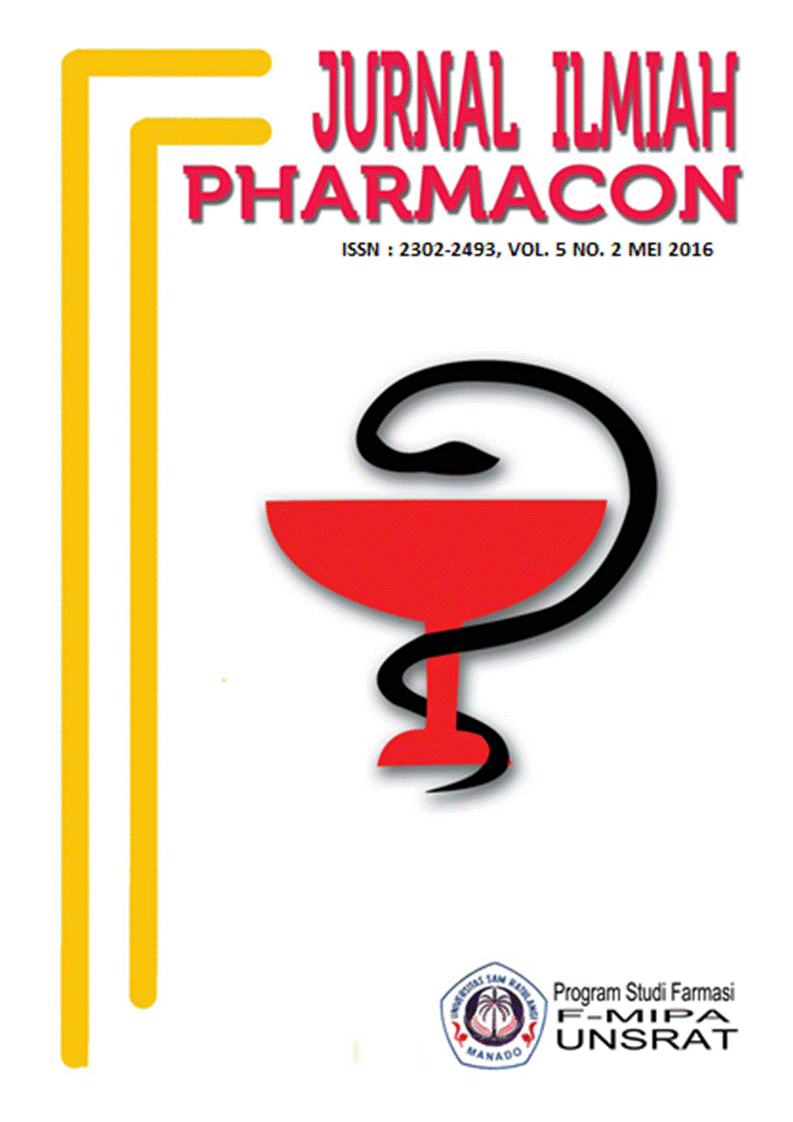GAMBARAN DENTURE STOMATITIS PADA PENGGUNA GIGI TIRUAN DI KELURAHAN WINANGUN SATU KECAMATAN MALALAYANG
DOI:
https://doi.org/10.35799/pha.5.2016.12166Abstract
GAMBARAN DENTURE STOMATITIS PADA PENGGUNA GIGI TIRUAN DI KELURAHAN WINANGUN SATU KECAMATAN MALALAYANG
Delvia T. Mandagi1), Damajanty H.C. Pangemanan1), Krista V. Siagian1)
1)Program Studi Pendidikan Dokter Gigi Fakultas Kedokteran Universitas Sam Ratulangi
Email: delviatrycsi@gmail.com
ABSTRACT
Denture stomatitis defined as inflammation of mucosa that usually occurs on removable denture users either in part or complete denture and it’s looks like a reds ones, sleek and painful. Purpose of this research was to described denture stomatitis on removable partial denture in Sub Winangun I Sub-district Malalayang. This research was a descriptive study with cross sectional approach with 60 samples obtained by using total sampling method. Research instrument using by denture stomatitis inspection sheet. The result showed that there were 26 respondent (43,33%) removable denture user suffering from denture stomatitis type I. Removable partial denture with aged 49-58 years 19,64% suffer from type II of denture stomatitis and complete denture with aged 59-68 years 50% suffer from type III of denture stomatitis. User female gender removable partial denture 26,79% suffer from type I of denture stomatitis and complete denture 50% suffer from type III of denture stomatitis. Based on the duration of use, user removable partial denture <5 years 33,93% respondent suffer type I of denture stomatitis and complete denture >5 years 75% respondent suffer type III of denture stomatitis. Based on the results obtained denture stomatitis type I and type III most common in Sub Winangun I Sub-district Malalayang.
 Keywords: denture stomatitis type I, type II, type III, user removable partial dentures and complete dentures ÂABSTRAK
Denture stomatitis merupakan suatu peradangan mukosa yang biasanya terjadi pada pengguna gigi tiruan lepasan baik gigi tiruan sebagian lepasan maupun gigi tiruan lengkap dan terlihat keadaan yang merah, licin serta terasa sakit. Tujuan penelitian ini untuk mengetahui gambaran denture stomatitis pada pengguna gigi tiruan sebagian lepasan di Kelurahan Winangun I Kecamatan Malalayang. Penelitian bersifat deskriptif dengan pendekatan cross sectional. Pengambilan sampel menggunakan metode total sampling dengan jumlah 60 responden. Instrument penelitian menggunakan lembar pemeriksaan denture stomatitis. Hasil penelitian menunjukkan bahwa pengguna gigi tiruan lepasan dengan jumlah 26 responden (43,33%) menderita denture stomatitis tipe I. Pengguna GTSL usia 49-58 tahun 19,64 % menderita denture stomatitis tipe II dan pengguna GTL usia 59-68 tahun 50% menderita denture stomatitis tipe III. Jenis kelamin perempuan pengguna GTSL 26,79% menderita denture stomatitis tipe I dan pengguna GTL 50% menderita denture stomatitis tipe III. Berdasarkan lama penggunaan, pengguna GTSL <5 tahun 33,93% menderita denture stomatitis tipe I dan pengguna GTL >5 tahun 75% menderita denture stomatitis tipe III. Berdasarkan hasil penelitian diperoleh denture stomatitis tipe I dan tipe IIIÂ paling banyak diderita di Kelurahan Winangun Satu Kecamatan Malalayang.
Kata kunci: denture stomatitis tipe I, tipe II, tipe III , pengguna GTSL dan GTL
Â
Downloads
Published
How to Cite
Issue
Section
License
Authors who publish with this journal agree to the following terms:
- Authors retain copyright and grant the journal right of first publication with the work simultaneously licensed under a Creative Commons Attribution-NonCommercial 4.0 International License that allows others to share the work with an acknowledgement of the work's authorship and initial publication in this journal.
- Authors are permitted and encouraged to post their work online (e.g., in institutional repositories or on their website) prior to and during the submission process, as it can lead to productive exchanges, as well as earlier and greater citation of published work (See The Effect of Open Access)










